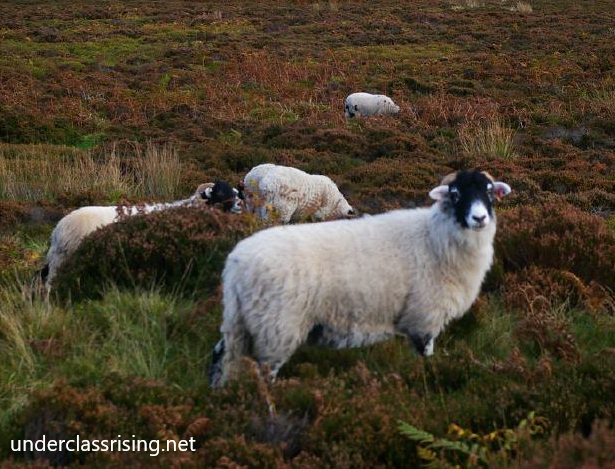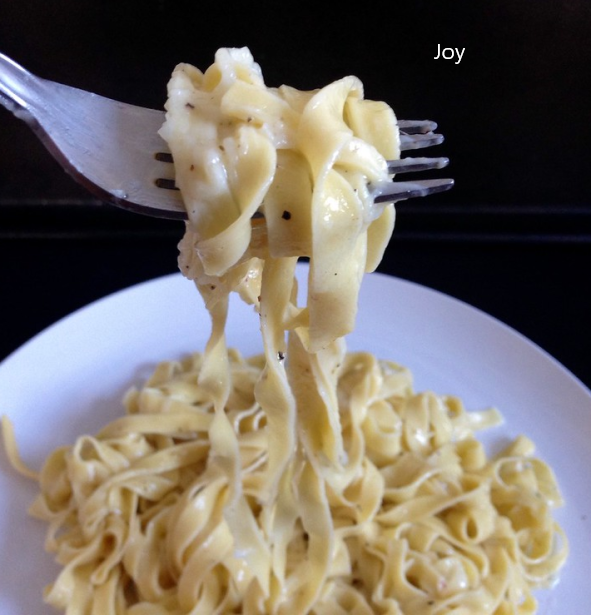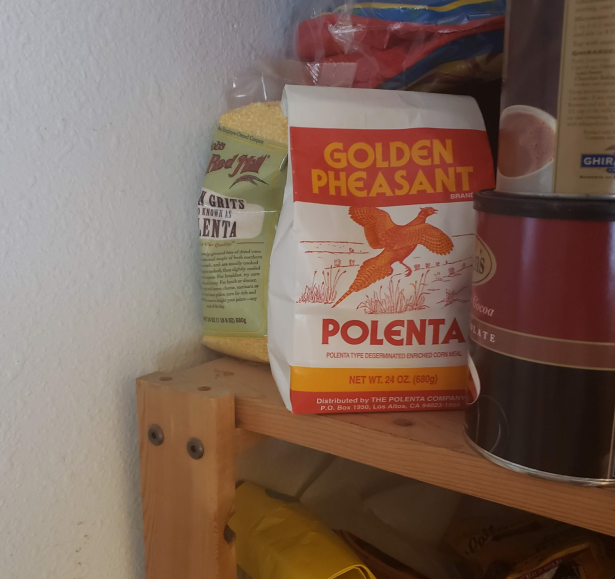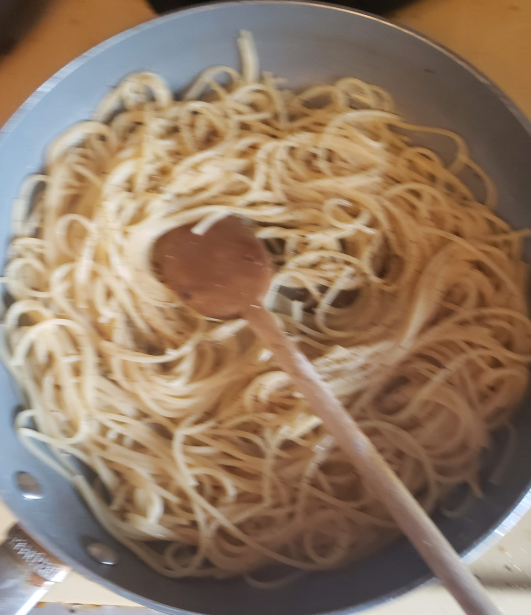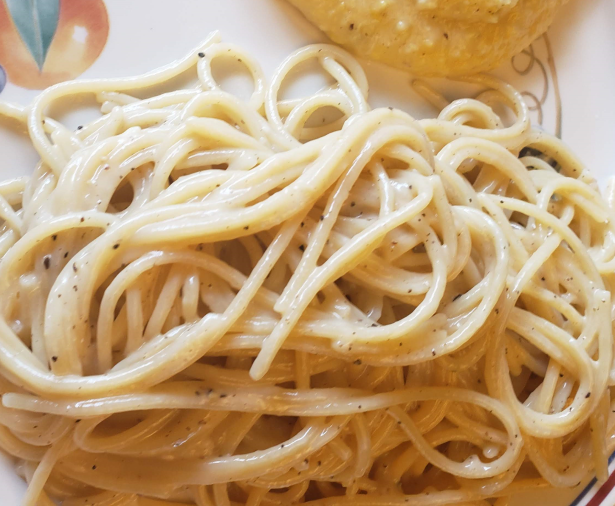Catastrophic Basics – Cacio e Pepe

Why hello there, and welcome back to some Catastrophic Basics. Today, we’re getting saucy, and I may try topping, as we cover a Roman dish that’s easier than pie, to help you make the most of your quarantine time. Cacio e Pepe! What does that mean? We’ll explain, but if you want to just get cooking, you can follow this link to some recipes that make a variety of starches using it.
Caci Falling Star and Put it in Your Pocket, Save it For a Rainy Day
Cacio e Pepe is an incredibly old Roman pasta whose name conveys just how old it is: Cacio (ka-chee-o) is Italian for Cheese, “e” means “and”, and “pepe” (peh-pey) means Pepper. It’s Cheese and Pepper. Specifically, black pepper.
Seen here, with more/less ingredients than you’ll technically need.
Yes, this is something of a “hard to discuss because of how little there is to discuss” sort of situations. Cacio e pepe is thousands of years old, supposedly born back during the Roman Empire, which…it’s not impossible, but it is a little weird. Because the story goes that during the Roman Empire, the dish was invented by shepherds: as they let their flocks roam the hills of Italy, they’d bring with them dried pasta, Pecorino cheese, and black pepper, since they’re all dried foods that can carry fairly well, and were relatively easy to get a hold of. Now, the pasta I get for that. And the Pecorino I can also see: Pecorino Romano is A, very Roman, as its name implies, and it’s used in a LOT of classic Roman pastas (though if you can’t find it, you can substitute the more broadly available Parmesan) and B, made from Sheep’s milk, so it makes sense the Shepherds would have easy access to it.
I mean, logically, who else is going to be milking these suckers?
The one that kind of bugs me is the pepper: Black Pepper was BIG business in Roman times, with Pliny the Elder listing the cost of black pepper at 4 denarii per pound. And a Denarius was somewhere around a day’s pay or more for many jobs at the time. Some historians equate it to around $20-25 in today’s money, since many things it could buy are cheaper now, meaning that even on the low end, black pepper cost about $80-100 a pound. Meaning that, even if you were buying it in small doses, you’d be spending like, a quarter of a day’s pay per ounce. I guess, mathematically, it’s not TOO weird, given the doses, it just feels slightly off for some reason.
Anyhow, the basic recipe uses five ingredients, 3 of which are so basic that modern recipes don’t even count them: Cheese, Pasta, Water, Salt, and Pepper. You can make it a little easier if you add butter, and there are a bunch of recipes that riff on it even further. I’ve seen the butter replaced with olive oil, and some crushed garlic briefly browned in it, I’ve heard of Bacon being added to it (which almost makes it Carbonara), or cream, or vegetables…Did I mention that a common nickname for the dish is “the Macaroni and Cheese of Rome”?
You might say, “Jon, that doesn’t look like macaroni and cheese” Which is a silly thing to say, since obviously it doesn’t, Macaroni is the specific pasta.
Yes, this Is the Kraft Mac and Cheese of devoted Roman mothers. And honestly? It’s almost as easy as the blue box. Which is why I personally made things harder on myself.
A Symphony of Starches for Puzzling Palates
Here’s the thing: once you have the cheese and pepper, it turns out there’s more places you can put them; more ‘blank canvas’ you can bedeck with the flavors of sharp salty cheese and slightly spicy black pepper. Cacio e Pepe Bagels exist, Cacio e Pepe Cream Cheese, Cacio e Pepe Potatoes, Pasta, Polenta, Pizza, and Popcorn. (So many Ps!)
Let’s change that pattern, by highlighting this Cacio e Pepe…Broccoli. We went from P to B. Great. Plosive to plosive.
You can get it on mushrooms, on Spaetzle, on Chicharrones, on Cauliflower. Inside arancini ( a dish I need to make one of these days). You can get it in desserts, like Cacio e Pepe Ice cream, or Shortbread. David Chang made Ceci e Pepe, making a miso-like fermented chickpea (Chickpeas are Ceci in Italian) paste and replacing the cheese with it.
There wasn’t going to be a picture here, then I found this one OF the Ceci e Pepe dish, and thought “well, shit, gotta grab that”.
Small author’s note: I don’t know if you can get ALL of these options anymore. Cacio e Pepe’s culinary heyday of explosive experimentation might have already passed by the time I write this in April (shit, technically May now) of 2020, and lord knows if it’s passed by the time you read it, in at LEAST May of 2020. I pulled my examples from an article written in early 2019, and I know for a fact that at least one of the cited restaurants has changed its menu to no longer feature the dish. Though I suppose that technically means you just need to make it yourself, or find somewhere else that will do it…)
Because of this, I have actually been intending to make Cacio e Pepe POLENTA for quite some time. I don’t know precisely how long, because these things often kind of bubble around in the back of my mind. Technically, I first saw the recipe for it a little over 2 years ago, in the Bon Appetit December 2017-January 2018 edition. But I don’t remember caring about it that long ago. Maybe I kind of did, and that’s why I’ve been reflexively buying bags of polenta for a while.
MORE. CORN.
Then I made polenta…almost exactly a year ago? Spooky. And only a couple months after I first started playing around with a pressure cooker. In the words of Kronk, “Oh yeah, I speak Squirrel.” …I don’t think that was the right quote. Whatever. Anyway, I got to the point where I was like “I want to make Cacio e Pepe polenta…but it’s a little weird to make it without making Cacio e Pepe first, right? Like, teach them to walk before they can run?” And then, this whole stay-at-home thing started, I ended up on a list of easy dishes to make at home, and boom, there was a thing for Cacio e Pepe Potatoes.
So I made all three. BECAUSE WHAT BETTER WAY TO TEACH YOU A METHOD than to OVERteach it!?
The Polenta
This is going to need a pressure cooker, and specifically a multicooker. The process is simple: 1 cup polenta, 4 cups water, several cracks of black pepper.
Twenty Five is “several”, right?
also, I realized when I edited this that I have a picture here of a Pepper Pot. Nice.
Stir thoroughly to combine, and bring to a simmer, stirring occasionally, cover, and pressure cook for 9 minutes. (Now, I had no problems with this method, but I HAVE read that a fair number of people encountered issues where their polenta started to clump up and burn on the bottom of the pot, triggering safety features. All those people found that they fixed the issue by just skipping the simmering step, so…you can play it safe if you want, but I didn’t have a problem, and I am WILDLY inept, as we will soon revisit.) Manually release the pressure (meaning “blast a huge plume of steam in your kitchen”), open up, and get ready to stir the shit out of this sucker. Because you’re about to beat this mixture smooth, before stirring in butter, and then 4 whole ounces of grated Pecorino Romano cheese.
I thought I had a picture of it measured out. Instead, just know that this container was FULL when the recipe started.
Now, because I’m wildly inept, I took the limited window of the pot pressure cooking to start the pasta, meaning I had to finish two dishes at roughly the same time, which is why this recipe doesn’t have any more shots OF the process: at this point I ran over to the stove to handle the pasta, and let Nate stir this pot. The results are nice.
A little like eating glue, but overall pleasant.
There’s a passivity to this recipe that’s not unpleasant. While there’s a quarter pound of cheese in the pot, it doesn’t come across as too salty. It’s warm and pleasant, without any huge flavors popping you in the mouth. Certainly something that would go well as a side starch for a meal, but maybe something you’d want to hit with a little more pepper and cheese if this Is your primary dish. Our batch also really came together nicely, forming into an almost soild unit once it cooled down.
The Pasta
This pasta cheats in several ways, and it went wrong in one important one. Firstly, the recipe I have for this pasta calls for ¾ cup parmesan or Grana Padano as its baseline Cheese. AS I noted earlier, Pecorino is the more traditional cheese, But it’s worth noting that these three cheese are OFTEN touted as acceptable substitutes for each other. Pecorino is a little sharper, and Grana is typically a little cheaper than the other two, but, like, Look, Murrary’s Cheeses has a tab literally labeled “Parmigiano and Pecorino”, and it includes Grana Padano.
I mean, look at this. Despite being Italian cheeses, despite being Hard cheeses, despite Pecorino being Sheep’s Milk, these two are so popular they get their OWN category.
So I went with the recipe, because, and this is something I didn’t tell you before now because it tends to panic people, but Cacio e Pepe has a slight reputation for being finicky. See, with so few ingredients, if things don’t go right, it’s very noticeable. And the specific thing that can go wrong with the pasta is making the sauce itself: see, the idea is that the hot starchy water from cooking the pasta melts the cheese, which binds with the starch and forms a sauce. If that doesn’t match up, you get seize up clumps of cheese, or a broken puddle of mess. I tried to make Cacio e Pepe once, YEARS ago, back while I was in Pullman, and ran into this issue a little. This time, I resolved I’d try some tricks to raise my chances: a little warmed up butter in a pan, and some super-starchy pasta water. How? By panning it.
The angle’s weird, but I assure you this is like, a 3” deep pan.
While most people are trained to cook pasta in big vats of pots, 5-6 quarts of water to the pound, you don’t actually HAVE to do that. You can cook pasta in less water in a shallower pan, which means the water will boil faster. There is ONE concern you have to think of with it. And that’s the old adage that pasta water should be “salty as the sea”, meaning you want a legit like, “My palm is full, and piled up” HANDFUL of salt for a full pot of water. That’s what I added: one nice handful of salt…to my “using half as much water to get more starch” pan. A fact I did not think of until later.
Anyway, pasta’s in the salted boiling water, you want it to cook for around 9 minutes for spaghetti, taking it out a couple minutes before it would be ‘done” because we’re going to finish it in the sauce, and then, about 4 minutes later, you’re going to want to melt some butter in another pan. THIS is where the two recipes got in each other’s way, as I had to stop stirring the freshly de-pressured polenta and handle this so the pasta didn’t overcook. The idea is that you crack at least a teaspoon of black pepper into the butter, to get a little tempering going on (by putting the pepper in the oil, you heat up its volatile oils, making it taste more peppery, and infusing the oil. The butter is going to help the cheese and starch come together. Pour some of the pasta water into the pan, and stir to mix the heated oil and water, and then, when the pasta’s done, turn off that burner, and just spider/scoop the pasta out of that pan and straight into the other. Don’t drain it: we want pasta water here.
We also wanted photographic stillness, but we can’t get everything.
And now, the steps are pretty simple: toss the ever loving SHIT out of the pasta. The more you stir, the more you’re going to agitate the starches, which are going to bind to the pepper oil and wick it onto the pasta. Once you see the strands starting to get speckled, start shaking in your grated cheese a bit at a time, along with a little extra pasta water. (You’re going to use probably around 2/3-3/4 a cup of pasta water in addition to whatever came on the pasta, just keep an eye on it.) Just keep tossing until it looks good and you’re all out of cheese. Then, crack some more black pepper on, and serve it up.
This is one of the better lighting shots I’ve gotten in a while.
I’m not going to lie, this pasta was slightly painful to eat, in a strangely good way. As noted, I had accidentally DOUBLED the salt in the cooking water, so this was a salty son-of-a-bitch, But it wasn’t inedible! The salt was just a sort of sharp punch to the taste buds delivered with every bite, and one that caused a slight burning sensation right around the thyroid glands. It somehow still kind of worked, with the creamy cheese and pepper. Nate noted that it was certainly too much salt, but not terrible.
Now, I was going to finish this post with Cacio e Pepe potatoes, but fuck that and fuck you. (BY WHICH Jon means “unfortunately, the potatoes turned out to be too difficult to work with”, a discovery that deeply upset him, as this was the THIRD batch of potatoes he had bought to make this dish with, and every time he’s taken too long to make the recipe, and the potatoes have turned green. TODAY he finally decided to push through that, and just peel the potatoes (since as long as you peel the skin from green potatoes, and trim any soft spots, they’re not very dangerous…except he was peeling BABY Yukon golds, so after 10 minutes, he had only peeled like, a 5th of all the potatoes, and his hands were getting slippery, leading to him nicking his knuckle with the peeler: his frustration peaked and he threw all the potatoes away, a process made more frustrating because he had intended these potatoes to be his breakfast, so he quickly revisited the Egg fold of two weeks ago as a quick and easy breakfast…but he didn’t put enough oil in the pan, and had to scrape it off the pan to salvage it. In short, he had a very frustrating morning, and doesn’t have the time to go re-buy potatoes and start the recipe, especially since he took an hour to eat his breakfast and calm down. The recipe, if you’re interested in trying it, is basically “boil 3 pounds of small potatoes for 15 minutes, drain, and toss in 1/3rd cup oilive oil, 1 tbsp black pepper, and a cup of grated pecorino romano, before topping with ANOTHER tbsp. of black pepper, and more Pecorino. He may make it soon.)
But the core is exposed: Black Pepper and a hard Salty cheese such as Pecorino, Parmigiano, or Padano. Tossed together and topping. The results are satisfying and filling, and simple to exectute. So give it a try!
I may not be the most visually intriguing dish, but it’s pretty good.
MONDAY: IF WE HAVE TIME, JON MAKES A MEAT AND BROTH DISH FROM A FANCY RESTAURANT THAT MAKES HIM SAD.
WEDNESDAY: JON DOESN’T KNOW OFFHAND. HE’S GOT A COUPLE OPTIONS, LET HIM GET SOME ROOM TO BREATHE, AND HE’LL WORK ‘EM OUT.
And now some
Recipes
Instant Pot Cacio e Pepe Polenta
Makes 4 servings
Ingredients
1 cup polenta (not quick-cooking)
4 cups water
1 teaspoon kosher salt, plus more
Freshly ground black pepper
3 tablespoons unsalted butter
4 ounces Pecorino and/or Parmesan, finely grated, plus more for topping
Preparation
IN the instant pot, mix together the polenta, water, a teaspoon salt, and some black pepper. Bring to a simmer, close, and pressure cook for 9 minutes. (You can skip the simmering step if it produces strange results) After 9 minutes, kill the heat, and release the pressure manually. Remove the lid, and prepare for STEP TWO.
Stir the polenta to fully integrate and smooth out the mixture. Then stir in more black pepper and butter until butter is fully melted. Then add grated cheese, stirring thoroughly to melt the cheese between each addition. Season with additional salt and pepper to taste, and serve warm.
Cacio e Pepe Pasta
Serves 2
Ingredients
6-8 ounces long pasta such as spaghetti
1.5-2 quarts water
2-3 tbsp salt (for the pasta water)
2 tbsp butter
1 tbsp cracked black pepper plus additional for topping
¾ cup grated Parmigiano Reggiano, Gran Padano, or Pecorino Romano
1/3 cup Pecorino Romano for topping
Preparation
Bring the water to a boil in a large pan, adding the salt and pasta, and cooking until shortly before the pasta’s cooking instructions.
In a separate pan (large enough to hold the pasta), melt the butter over medium-low heat. Add the cracked black pepper and heat for 1-2 minutes. Reserve at least ¾ cup of pasta water. Add ¼ cup pasta water, stirring to incorporate with butter, before adding pasta and tossing frequently to coat.
Remove pan from heat, and add grated cheese a bit at a time, adding additional pasta water to thin as needed, until all components are integrated. Top with additional black pepper, and more Pecorino and serve.


